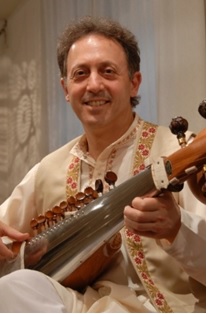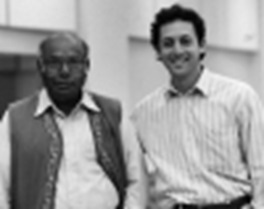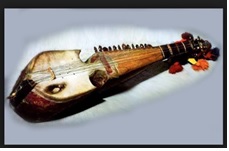Many music lovers around the world are familiar with the sweet resonant sound of the Sitar, a popular string instrument from India. Like the sitar, the Sarod is another popular instrument from India that is known for its deep and sonorous sound. The steel clad, metal string, short necked lute without frets played with a coconut shell plectrum is believed by some to be a descendant of the “rubab†that originated in Central Afghanistan.
Internationally acclaimed Sarod player Ken Zuckerman will conduct a two hour long workshop titled “Modal Improvisations†Friday, April 10 between 11AM and 1PM in room B36 at the College of Fine Arts, 855 Commonwealth Ave. The workshop is suitable for all musicians and is free and open to the public. On Saturday, April 11 at 6pm Zuckerman will play at a MITHAS concert at MIT’s Wong auditorium. He will be accompanied by the well-known tabla player Shri. Nitin Mitta.
Zuckerman (currently visiting the US from Switzerland) is one of the most gifted disciples of the legendary Sarod player, the late Ustad Ali Akbar Khan, a MacArthur fellow who won the prestigious traditional arts fellowship from National Endowment of Arts. Zuckerman teaches courses on improvisation on medieval music at several schools of music including the Ali Akbar Khan College of music located in Basel, Switzerland.
What is improvisation and why must we study it? Zuckerman explains “Improvisation is a universal subject that lends itself to many human activities such as cooking, crafting, storytelling, poetry, comedy among others. Although it is a common word, used to describe a variety of experiences in our everyday lives, its specific meaning in relation to music is often times vague and invites misunderstandings in both musicians and listeners alike. This is easy to understand once we realize that although some aspects of improvisation can be analyzed and quantified, much of the essence of both its internal workings and external “charm†remain, if not completely subjective, at least very personal and rather difficult to put into words. Musicians sometimes describe the process as being mysterious, unconscious, spontaneous, and many are not quite sure why it is sometimes effortless and at other times difficult. Almost all musicians acknowledge that it requires a long and extensive practice in order to become a fluent and intelligent improviser. “
Composers throughout history have used improvisation as a tool for developing musical ideas and to help setup an atmosphere for inspiration and creativity. Improvisation is an important measure of a musician’s skill and ability. Although some western musicians have had experience with improvisation, it remains nevertheless on the fringe of western music practice and education.
The workshop titled “Modal improvisations†will address improvisations in the area of musical modes, a concept that is at the core of eastern music traditions. In the theory of music in Western music, mode (Latin word modus "measure, standard, manner, way, size, limit of quantity, method") generally refers to a type of scale (an ordered set of musical pitches) coupled with a set of characteristic melodic behaviors. The common thread that runs through almost all musical traditions of East-West is the mode.
Indian music revolves around the concept of “ragasâ€, which are melodic movements that are similar to modes in many ways. Like modes, ragas use selected musical notes ( much in the fashion of a scale) and practitioners/performers need to stick to the selected notes to develop the structure of a particular raga. In Indian music thousands of modal frameworks exist under the general term raga. Many times there are a large number of ragas which share the same “parent†scale – like dorian – but each one has its own distinct identity and rules for composition and improvisation.
The specific knowledge of how the notes of a raga are approached stylistically and the musical ornamentations that create its unique personality, such as a glissandi (smooth glide from one note to another or a perhaps a weighty tremor around a note), is very important in raga music and must be acquired directly from a teacher. While there exists freedom to improvise within the framework of each raga, inherent and implied rules surrounding each raga must at all times be adhered to and respected by the practitioner. Zuckerman will demonstrate these key features in his workshop on April 10.
One wonders if the journey into the world of ragas and modes been easy for Zuckerman, a US born Jewish American citizen. Zuckerman started out with playing acoustic as well as electric guitars and composing jazz/ folk music. †I grew up in the midst of a great cultural curiosity in everything from the “eastâ€. I must admit however, that I was not actively involved in the movement and I barely noticed some of the momentous “Indian†events of the late 1960’s – George Harrison with his sitar, Ravi Shankar at the Monterey Pop Festival, etc. But as a music student in my own culture, I was gaining experience in a number of western musical styles. There were elements in many kinds of music that I found attractive – from folk music to rock’n’roll, to jazz and classical. I was also very interested in composing and improvising. But somehow I was not completely satisfied by any one style and was searching for my proper place as a musician. It was at this moment that I had the good fortune to see Ustad Ali Akbar Khan perform at the university where I was studying.†says Zuckerman.
His fascination with the legendary Sarod player, Ali Akbar Khansahib eventually led him to California to try out a summer studying Indian music under this master. Beginning his studies with the sitar, Zuckerman later switched to the sarod and completed thirty-seven years of rigorous training with Maestro Khan.
At one point in his study of music, Zuckerman became fascinated with the relationships between Indian and Western music. “Particularly in the area of western music of the Middle Ages, I observed many similarities in terms of modes, melodic styles, rhythmic construction and ornamentation. Although there are very few written documents from this early period of western music, it became clear that there were a number of interesting similarities, especially in the repertoire of medieval monophonic songs and instrumental dances. These forms also exhibit strong evidence of a non-written, improvised tradition of music-making existing alongside the written repertoire.†says Zuckerman.
Questions such as: What was the nature of improvisation in earlier times? How were musicians trained in this art? Can one ever hope to incorporate this “spontaneous†practice into the “reconstruction†of medieval music? led Zuckerman to research the subject of improvisations in modal music. In the workshop on Friday, April 10 at 11AM, at CFA, 855 Commonwealth Ave, Room B36, Ken Zuckerman will discuss his research and conclusions, present basic concepts of raga music and encourage participants to explore spontaneous improvisation. Interested participants are encouraged to bring their instruments to the two hour long workshop.
The MITHAS concert on April 11 at Wong auditorium at 6pm will give listeners a chance to listen to a concert by Ken Zuckerman and Nitin Mitta.


